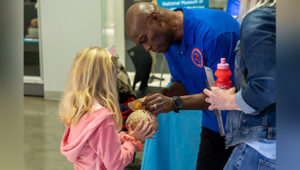
Courtesy Story
Defense Health Agency
Traumatic brain injuries, one of the invisible wounds of war, affect many in the military and civilian populations. According to the Centers for Disease Control and Prevention, about 1.7 million people sustain TBIs annually, and since 2000, over 490,000 service members have sustained a TBI.
During this year’s Brain Injury Awareness Month, staff from the Department of Defense, and government and professional organizations participated in the National Museum of Health and Medicine’s annual Brain Awareness Day to teach visitors about TBIs and ongoing research and resources related to the brain and brain health.
“NMHM has a 160-year history of documenting military medicine’s approach to understanding and treating brain trauma and disease,” said Andrea Schierkolk, the museum’s public programs manager. “Programs like Brain Awareness Day provide an opportunity to communicate the importance of making these collections available to researchers and clinicians who are investigating ways to improve the health and readiness of our service members.”
Interactive brain games and exercises were the spotlight of the 2024 Brain Awareness Day.
The Society for Neuroscience provided activities for visitors to assess their reaction time, balance, and interpretation of visual information.
Similarly, the Uniformed Services University offered a craft activity where visitors could build a neuron with pipe cleaners, beads, and a foam ball. Throughout the activity, USU volunteers explained how neurons are the communicating cells in the brain.
The National Institute of Neurological Disorders and Stroke used its Lobe-oratorium® to show how the brain directs every process that enables humans to function.
“The Lobe-oratorium® is a really cool display with an interactive component where kids can learn about the different lobes of the brain and how they help them do everything in life from walking, talking, eating, sleeping, learning, [and] playing music,” said Diana Andriola, a science education and outreach specialist at NINDS.
National Intrepid Center of Excellence staff showcased a variety of games and exercises to promote mindfulness and demonstrate basic activities used for therapeutic rehabilitation of a TBI.
“We provide therapeutic interventions to service members who have a traumatic brain injury,” said Jonathan Choy-Yuen, a speech-language pathologist at NICoE. “We have lots of different services ranging from health care providers to audiologists to speech pathologists and [physical therapists]. We really work with the patient to gain back function they have lost over time due to traumatic brain injury and other psychological conditions, such as [post-traumatic stress disorder].”
Heather Kopf, regional education coordinator at the Traumatic Brain Injury Center of Excellence, emphasized helmet safety, and she handed out materials describing how to identify and treat concussions and mild TBIs.
“Concussion is the most prevalent form of brain injury or TBI in the military,” she said.
Kopf emphasized that while TBIs can be sustained during combat, everyday activities also hold risks for both service members and civilians. She detailed the symptoms and signs of a mild TBI for museum visitors while walking them through a mirror tracing exercise used to help identify neuropsychological damage.
NMHM staff were also available at two stations.
Elizabeth Lockett, the Human Developmental Anatomy Center collections manager at the museum, taught visitors about neural tube development and the formation of a baby’s brain and spinal cord during gestation. Lockett used embryo models made by Osborne O. Heard for the Carnegie Institute of Washington as visual aids as she described the causes of neural tube defects.
A long-time participant at the museum’s Brain Awareness Day program, Archibald Fobbs, the neuroanatomical collections manager, showcased a collection of the museum’s brain slides that included a normal human brain and a dolphin brain. Situated in front of the museum’s exhibit on TBIs, Fobbs described TBIs, how to prevent them, and how TBIs impact the military.
NMHM’s public programs provide forums for informal learning that connect the mission of the DOD museum with the public. NMHM was founded as the Army Medical Museum in 1862 and is a branch of the Defense Health Agency Research and Engineering Directorate. For more information about upcoming events, call (301) 319-3303 or visit https://www.medicalmuseum.health.mil.